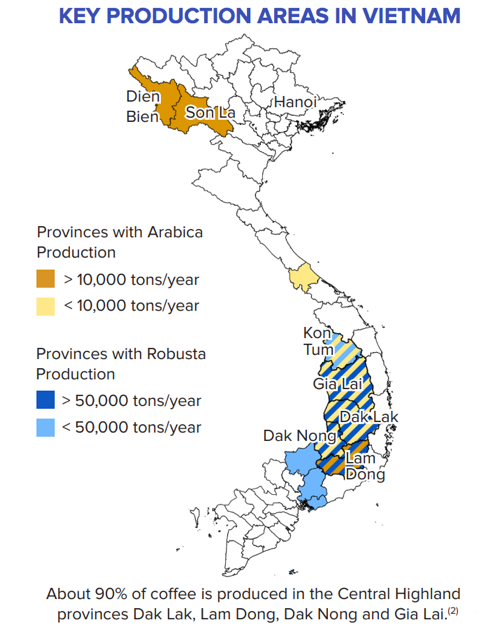Vietnam’s coffee industry has experienced rapid growth since its beginnings in 1975. With approximately 600,000 hectares of coffee farmland, Vietnam is currently the largest producer of Robusta coffee in the world and the second largest producer of coffee globally, second only to Brazil (FAO 2020). On average, Vietnam produces over 2.3 metric tons of coffee per hectare, one of the highest rates in the world (ICO 2019).
Given these facts, it’s no surprise that coffee plays an important role in the country’s agriculture sector:

The majority of coffee production in Vietnam takes place in the Central Highlands region, in the following four provinces: Dak Lak, Lam Dong, Dak Nong, and Gia Lai.

(Image Source: Sustainable Coffee Challenge)
The rapid growth of Vietnam’s coffee sector can largely be attributed to the Vietnamese government’s efforts to develop the Central Highlands region, which is rich with natural resources (Marsh 2007). To catalyze the growth of the coffee industry there, the government provided farmers with subsidies and agricultural planning information. As a result, the population of the Central Highlands increased by 2.7 million in just 15 years (Marsh 2007).
While there are large government-managed farms, 95% of coffee producers in Vietnam are private, smallholder farmers with many households having approximately one hectare of farmland or less (ICO 2019).
Vietnam does produce Arabica coffee, but Robusta coffee prevails as the main type of coffee grown in the country, accounting for 97% of production (ICO 2019). Robusta coffee contains more caffeine than its counterpart, Arabica, and therefore is known to have a more bitter taste. However, Robusta is much easier to grow due to its resistance to pests and diseases and low production costs (ICO 2019). While Robusta is not valued as highly as Arabica, it has still proved to be profitable for farmers when yields are high.
The Vietnamese government would like to maintain the country’s coffee growing area to its current size of around 600,000 hectares, therefore recent government initiatives have been focused on improving the quality, quantity, and revenue of coffee beans. These initiatives have included the encouragement of increased Arabica production and the replacement of older coffee trees to improve efficiency, among others (ICO 2019).
Notably, the government’s Sustainable Coffee Plan was released in 2014 and includes direction on how to address the vulnerabilities the coffee sector will face both environmentally and economically (ICC 2019).
Fun Fact: A few years ago Vietnam designated December 10 as National Coffee Day.
Sources:
FAOSTAT. Top 10 Country Production of Coffee. Retrieved June 25, 2020, from http://www.fao.org/faostat/en/
International Coffee Organization. (2019). Country Coffee Profile: Vietnam. Retrieved June 29, 2020, from http://www.ico.org/documents/cy2018-19/icc-124-9e-profile-vietnam.pdf
Marsh, A. (2007). Diversification by smallholder farmers: Viet Nam Robusta coffee. Food and Agriculture Organization of the United Nations.
Sustainable Coffee Challenge. Coffee Production in the Face of Climate Change: Vietnam. Retrieved June 23, 2020, from https://www.sustaincoffee.org/assets/resources/Vietnam_CountryProfile_Climate_Coffee_6-11.pdf
